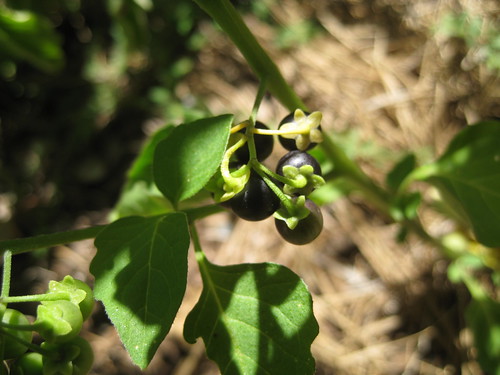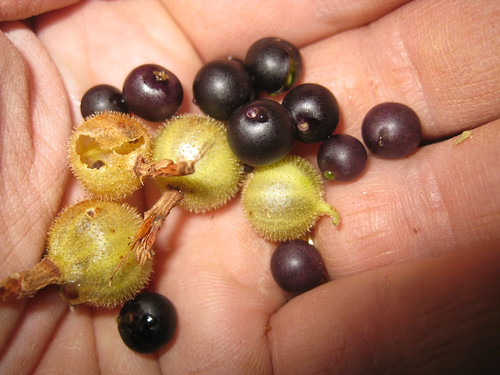 Solanum nigrum, a small, weedy relative of the tomato and its kin, has volunteered in the garden proper, and some of the fruits are ripe. Small and seedy, it has a pleasant, lemony sort of tomato sweetness. It’s a much maligned plant, often confused, at least in the literature, with the poisonous deadly nightshade (Atropa belladonna). In Nature’s Garden, author Samuel Thayer provides a well-researched and in-depth discussion of the topic, and lands squarely in the “eat it” – after positive ID, of course – camp. Incidentally, Nature’s Garden is a really wonderful book, as is The Forager’s Harvest by the same author, and both are a source of inspiration. I have come to trust Thayer, and have sampled the nightshade fruits and collected black nightshade seeds to spread in various parts of the food forest.
Solanum nigrum, a small, weedy relative of the tomato and its kin, has volunteered in the garden proper, and some of the fruits are ripe. Small and seedy, it has a pleasant, lemony sort of tomato sweetness. It’s a much maligned plant, often confused, at least in the literature, with the poisonous deadly nightshade (Atropa belladonna). In Nature’s Garden, author Samuel Thayer provides a well-researched and in-depth discussion of the topic, and lands squarely in the “eat it” – after positive ID, of course – camp. Incidentally, Nature’s Garden is a really wonderful book, as is The Forager’s Harvest by the same author, and both are a source of inspiration. I have come to trust Thayer, and have sampled the nightshade fruits and collected black nightshade seeds to spread in various parts of the food forest.
 The wild gooseberries that are found throughout the property, and that planted the idea of the food forest in my mind years ago are fruiting, and these too I’ve collected in order to save and germinate seeds. I’m toying with the idea of grafting other gooseberry cultivars onto these native plants, which seem to thrive even in some of the hottest parts of the property, without care or supplemental water. In other news, a cutting of Laurus nobilis, the Grecian Bay Laurel I planted years ago in the garden proper, has rooted! I plan to transplant this tree as a pioneer species in a new food forest plot in the southeast corner of the property, perhaps in the fall.
The wild gooseberries that are found throughout the property, and that planted the idea of the food forest in my mind years ago are fruiting, and these too I’ve collected in order to save and germinate seeds. I’m toying with the idea of grafting other gooseberry cultivars onto these native plants, which seem to thrive even in some of the hottest parts of the property, without care or supplemental water. In other news, a cutting of Laurus nobilis, the Grecian Bay Laurel I planted years ago in the garden proper, has rooted! I plan to transplant this tree as a pioneer species in a new food forest plot in the southeast corner of the property, perhaps in the fall.

